Cavalry advances without noticing water obstacles.
Although the number of cavalry in the Red Army all the prewar years was steadily declining, it was too early to write off the cavalry from the accounts, which the Great Patriotic War clearly demonstrated. Back in 1938, the Red Army had 32 cavalry divisions and 7 corps directorates, but it entered the war, having already only 13 cavalry divisions and 4 corps. At the same time 4 of these divisions were mountain cavalry and had a lighter composition. The revival of cavalry was largely facilitated by the outbreak of war, unsuccessful for the Soviet Union.
After the 1941 summer of the year, as the snow under the bright sun, the Soviet mechanized corps literally melted in the tragedy of the border battles, the Red Army was almost deprived of the most important tool of warfare - mechanized units. The only real substitute for mech joints, although inferior to them in mobility, was cavalry. At the same time, the tactics of the battle of the Soviet cavalrymen differed little from the tactics of the battle of the motorized infantry. Motorized infantry used cars and armored personnel carriers as a transport, entering into battle in a hurried manner. The cavalrymen acted similarly. Horses were used only to transport soldiers to the battlefield; the cavalrymen themselves fought in infantry chains. Attack in the equestrian system was very rare. According to the military regulations of the cavalry, such attacks could be carried out only under favorable conditions, when shelters allowed, and also the weakness or absence of enemy fire.
By the end of 1941, the Red Army included 82 cavalry divisions, albeit of a light type of 3447 personnel. In the pre-war states, the cavalry division numbered 8968 manpower. The cavalry divisions reached their maximum number in February of the 1942 year, when they already had 87 in the army. Then the number of divisions began to decline again. So on 1 in May 1943 of their year was already 26, however, the number of these compounds grew, there were 238 968 people and 226 816 horses in them.
Unlike road transport, horses as a means of transportation and a corpulent force had a number of advantages - they moved better on conventional roads and off-road, were not dependent on fuel supplies (a serious problem in wartime conditions), could live on ordinary pasture, and often themselves became food, saving people from starvation. In the spring of 1942, many Soviet cavalry divisions that had fallen into the encirclement partially ate the existing horses, but managed to break free from the grip of the Nazis.
The cavalry was highly mobile, and at the initial stage of the war these units could easily hide from the German dominant in the sky aviation in large forests. As you know, with cars and tanks you can’t go far into the forest. The cavalry succeeded and it was better to ford numerous water barriers. It is worth noting that the issue of river forcing was described in great detail in the military guiding documents of the cavalrymen, first the tsarist, and then from the Workers 'and Peasants' Red Army. Approaching the water barrier, the cavalrymen first of all organized a thorough reconnaissance. In this case, there were several types of river crossing horse units: on bridges, on special watercraft (rafts, boats, ferries), ford and swim. The last way to overcome the water barrier was a distinctive feature of this kind of troops.
The passage of cavalry units on the bridges was carried out on foot. Riders at the same time moved along the edge of the bridge, holding the horses in the direction closer to its central part. Horsemen cavalrymen drove horses under the bridles. In quadruple sleds, the harness horses, when crossing, were reeled off, they were led separately. At the same time, the distance during the passage of bridges between divisions increased, and the stops of divisions on the bridge were strictly prohibited. The only possible reason for the column to stop was the swinging of the bridge to the extent of the loss of stability of the horses.
At the same time, one of the very common and often found in cavalry ways to force water barriers was fordings. The presence of a ford on the river was determined by a number of signs: the presence of paths and field roads to the river (the most obvious sign), the broadening of the river on straight sections of the current, islands visible above the water surface, shallows and rifts, low-lying banks. The table below shows the permissible depths and speeds of the current, clearly confirming the advantage of cavalry when fording rivers:
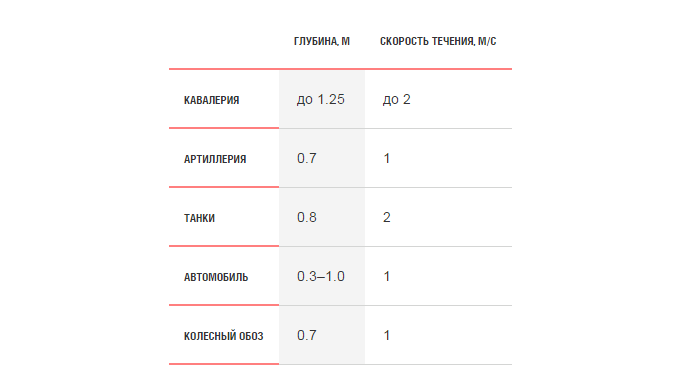
When organizing forcing water obstacles ford, it was necessary to carry out preliminary exploration: determine the depth, nature of the shore and bottom soil, the speed of the river flow, cut off steep descents to the water and eliminate other obstacles. The width of the ford was marked with the help of fixed milestones. With the rapid flow of the river across, they tried to pull the rope that connected the wagons filled with stones or other cargo. Were forwarded by closed formations, as the cavalrymen leading in front smashed the bottom, complicating the rear movement. At the quad carriages of machine-gun carriages, the straightening horses, like during the movement on the bridges, were retracted and carried on separately. At the same time, during the crossing for the separate horsemen without a special team it was categorically forbidden to stop in the river and water the horses. The watering hole was organized by the entire composition of the units above the ford along the river while they were waiting for their turn to make the transition.
Crossing of the cavalry units across the river by swimming was carried out in three possible ways:
- With a small width of the river (30-50 meters) riders crossed the river with full equipment and weapons;
- When the width of the river is more than 50 meters, riders removed uniforms and weaponwhile fastening it to the saddle, the weapon needed to be bored upwards.
- In the presence of ferrying means riders were transported across the water barrier light. Their weapons and uniforms were collected and transported on rafts or boats, and then handed out back.
For crossing the river, swimming columns were used one by one, two by one, and columns of links. The recommended intervals between riders in this case were equal to 3-6 meters, and the distance - to 8 meters. Until the moment when the horse was under the horse’s bottom, the horseman was riding, but as soon as the horse lost the bottom, the horseman had to slip into the water and swim next to the horse, holding the mane with one hand. At the same time it was recommended to let the most experienced and courageous horses go ahead. If the horse refused to sail and rushed to other horses, it was among the last to be shipped. At the same time, if already during the crossing some animal escaped and started to swim away, they did not try to catch it, in order not to disturb the general construction and not to lose the given crossing rate. The escaped horse was caught on the shore, to which she sailed alone.
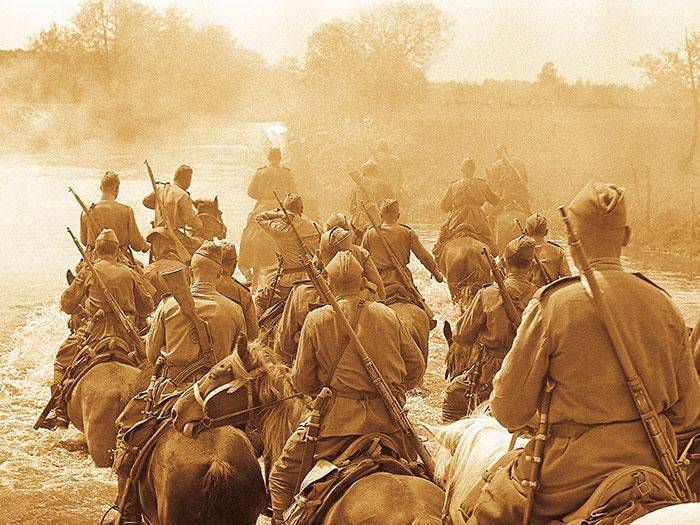
At the same time, cavalry units had the advantage of crossing water obstacles not only in the summer months, but also in winter. The cavalry crossing over the frozen ice was allowed with ice thickness: for individual riders - 13 cm; for open order - 16 see
Before the start of the ice crossing, reconnaissance was also carried out:
- ice thickness;
- depth of snow cover on the ice and on the banks of the reservoir;
- the state of ice off the coast;
- indicated the boundaries and directions of the crossings in width, polynyas, ice holes and fissures were enclosed;
- descents and exits to the reservoir, determined the availability of materials (straw, boards, brushwood), which could be used to strengthen the ice;
- continuous monitoring of the ice cover was conducted.
Crossing cavalry on the ice was carried out in a hurried manner. Riders led the horses about, moving in wide open formations. At the same time, wagons and artillery guns moved non-stop, spreading out as many paths as possible. After the battles, the condition of the ferries was clarified. Wormwood appearing on reservoirs from shell explosions and mines enclosed. Thus, the ability of cavalry units to quickly force various water barriers remained one of those factors that allowed it not to lose its relevance until the victorious conclusion of World War II.
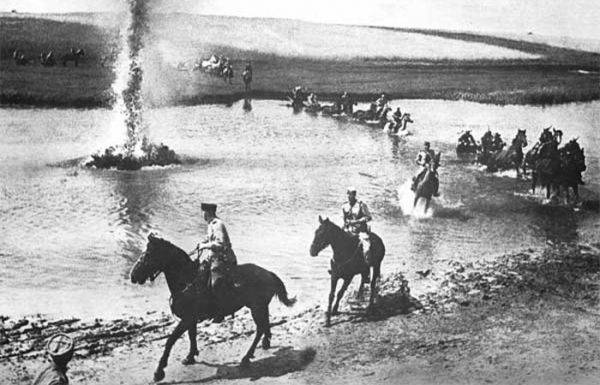
The cavalry of the Red Army took part in all major battles, from the very first tragic days of the war to the last operations in Europe in the spring of 1945. The Soviet cavalry divisions played a very important role during the counteroffensive at Stalingrad, where they formed the external front of the encirclement of the German group. In January 1943, the 7 Cavalry Corps passed 6 km almost without rest on 280 days and January 15 captured Valuyki station, creating an outer ring of the environment of the enemy-Russian rossoshanskoy grouping. The result of the Ostrogozhsk-Rossosh operation was the liberation of the Soviet territory with a total area of 22,5 thousands of square kilometers, the capture of 86 thousands of prisoners. During the operation, the 2-I Hungarian Army, the Italian Alpine Corps, the 385-I and 387-I German infantry divisions, as well as a separate division group, Fogelein, were defeated.
Cavalry units were also successfully used in the 1944 year in Belarus, especially in wooded and swampy areas, as part of the offensive operation Bagration. The cavalry was part of cavalry-mechanized groups, acting in close cooperation with tank units. By forcing the Berezina, the 3-th Guards Corps corps managed to create a bridgehead on the river bank, preventing the Germans from turning the water barrier into a line of defense to restore the front line. Later, by cutting off the Minsk-Vilnius railway, the cavalry units of the Red Army deprived the enemy's Minsk grouping of the most important escape routes to Vilnius and Lida.
About how Soviet cavalrymen fought, says the fact that 7 8 from the corps that existed at the end of the war had the honorary title of the Guards. At the same time, part of the cavalry was represented by fighters recruited on the Don and Kuban - the most real Soviet Cossacks. During the Great Patriotic War, two cavalry corps were officially called "Cossack". So in 1945, the 4-th Guards Kuban Cossack Corps liberated the capital of Czechoslovakia - Prague, and the 5-th Guards Don Cossack Corps reached Fighting Vienna.
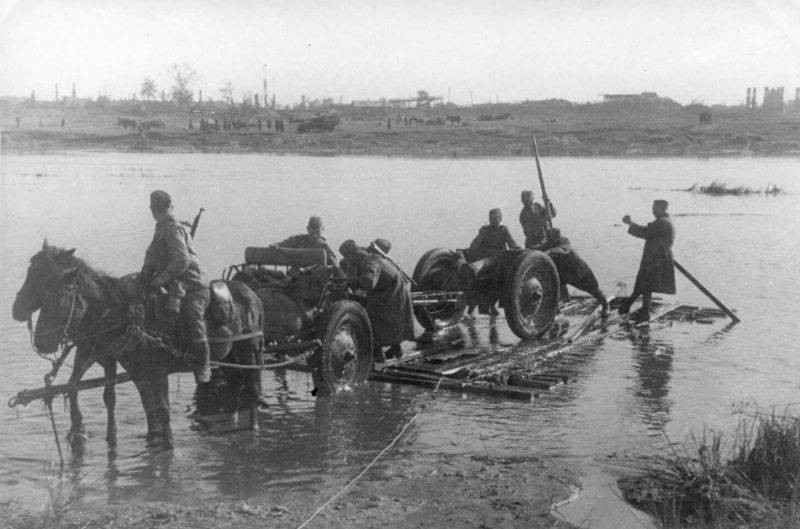
And on April 26, 1945, in an assault on the city of Brandenburg, located 40 kilometers west of Berlin, the 7 Guards Cavalry Corps took part in the final offensive operation of that war, closing the encirclement around the capital of the Third Reich. All in all, in the Berlin operation, the Red Army used 12 cavalry divisions, in which almost 100 served thousands of soldiers and officers. Contrary to the myths common today, the cavalry proved to be an effective and full-fledged participant in that terrible war from the first to the last of its day. Thus, the Second World War was not only the first major war of engines, but also the last great war of cavalry and horsepower.
Information sources:
http://warspot.ru/1820-perehodim-etu-reku-vbrod
http://rusplt.ru/wow/add/velikaya-otechestvennaya--poslednyaya-voyna-kavalerii-16619.html
http://fablewar.ru/2012/01/commons
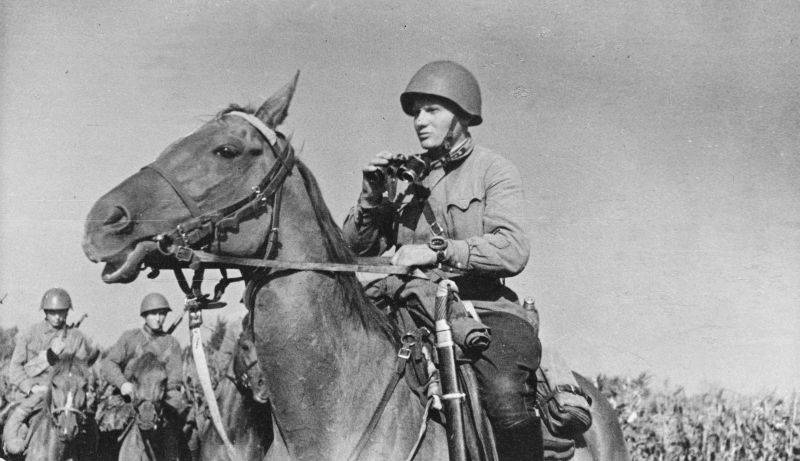
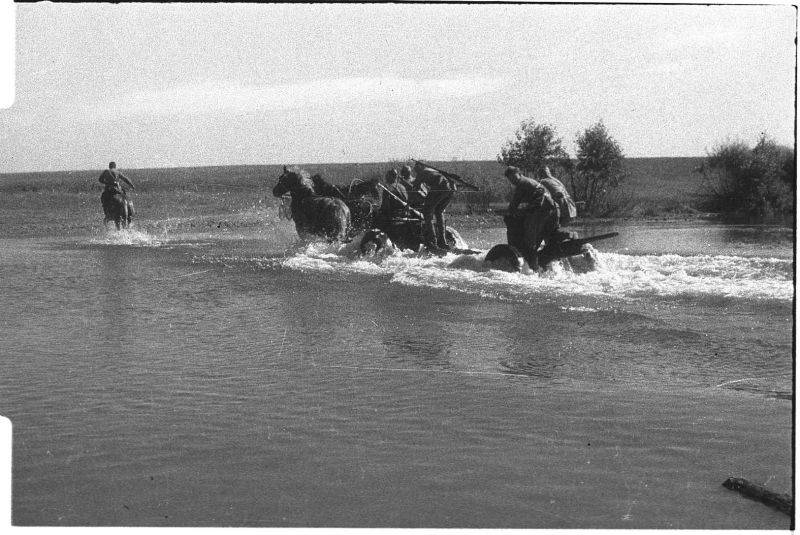
Information